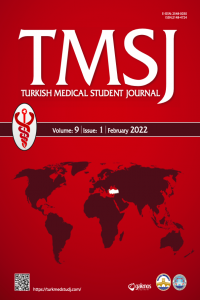THE EFFECTS OF ACYCLOVIR ON ANGIOGENESIS IN CHICK CHORIOALLANTOIC MEMBRANE MODEL
THE EFFECTS OF ACYCLOVIR ON ANGIOGENESIS IN CHICK CHORIOALLANTOIC MEMBRANE MODEL
Angiogenesis, acyclovir, chorioallantoic membrane, endothelial cells,
___
- 1. Balfour HH. Antiviral drugs. N Engl J Med 1999;340(16):1255-68.
- 2. Gnann JW, Barton NH, Whitley RJ. Acyclovir: mechanism of action, pharma- cokinetics, safety, and clinical applications. Pharmacotherapy 1983;3(5):275-83.
- 3. Razonable RR. Antiviral drugs for viruses other than human immunodeficiency virus. Mayo Clin Proc 2011;86(10):1009-26.
- 4. De Clercq E. Antiviral drugs in current clinical use. J Clin Virol 2004;30(2):115- 33.
- 5. De Clercq E, Li G. Approved antiviral drugs over the past 50 years. Clin Microbiol Rev 2016;29(3):695-747.
- 6. Gold D, Corey L. Acyclovir prophylaxis for herpes simplex virus infection. Anti- microb Agents Chemother 1987;31(3):361-7.
- 7. Field HJ, Goldthorpe SE. Antiviral drug resistance. Trends Pharmacol Sci 1989;10(8):333-7.
- 8. Shaimerdenova M, Karapina O, Mektepbayeva D et al. The effects of antiviral treatment on breast cancer cell line. Infect Agents Cancer 2017;12(1):18.
- 9. Benedetti S, Catalani S, Palma F et al. Acyclovir induces cell cycle perturbation and apoptosis in jurkat leukemia cells and enhances chemotherapeutic drug cyto- toxicity. Life Sci 2018;215:80-5.
- 10. Lokman NA, Elder ASF, Ricciardelli C et al. Chick chorioallantoic membrane (CAM) assay as an in vivo model to study the effect of newly identified molecules on ovarian cancer invasion and metastasis. Int J Mol Sci 2012;13(8):9959-70.
- 11. Nowak-Sliwinska P, Segura T, Iruela-Arispe ML. The chicken chorioallanto- ic membrane model in biology, medicine, and bioengineering. Angiogenesis 2014;17(4):779-804.
- 12. FDA-approved drugs (website) (cited 2021 October 10). Available from: URL: https://www.accessdata.fda.gov/scripts/cder/daf/index.cfm?event=overview.pro- cess&ApplNo=020089.
- 13. Zhou Q, Qi C, Li Y et al. A novel four-step system for screening angiogenesis inhibitors. Mol Med Rep 2013;8:1734-40.
- 14. Bürgermeister J, Paper DH, Vogl H et al. LaPSvSd1, a (1-->3)-beta-galac- tan sulfate and its effect on angiogenesis in vivo and in vitro. Carbohydr Res 2002;337(16):1459-66.
- 15. Paper DH, Vogl H, Franz G. Low-molecular-weight galactan sulfates as angiogen- esis inhibitors. Contribu to Oncol 1999;54:191-9.
- 16. Karaman H, Tufek A, Karaman E et al. Opioids inhibit angiogenesis in a chorio- allantoic membrane model. Pain Phys 2017;20(2):11-21.
- 17. Kılıççalan İ, Erkovan A, Sen E. Caenorhabditis elegans and angiogenesis. Turkish Med Stud J 2019;6(1):37-41.
- 18. Brand M, Lamandé N, Larger E et al. Angiotensinogen impairs angiogenesis in the chick chorioallantoic membrane. J Mol Med 2007;85(5):451-60.
- 19. Ribatti D. The chick embryo chorioallantoic membrane (CAM). A multifaceted experimental model. Mech Dev 2016;141:70-7.
- 20. Kominsky SL, Subramaniam PS, Johnson HM et al. Inhibitory effects of IFN-gamma and acyclovir on the glioblastoma cell cycle. J Interferon Cytokine Res 2000;20(5):463-9.
- 21. Lu H, Han Y-J, Xu J-D et al. Proteomic characterization of acyclovir-induced nephrotoxicity in a mouse model. PLoS One (serial online) 2014;9(7). Avail- able from: URL: https://journals.plos.org/plosone/article?id=10.1371/journal. pone.0103185.
- 22. Rajabi M, Mousa SA. The role of angiogenesis in cancer treatment. Biomedicines 2017;5(2):34.
- 23. Lugano R, Ramachandran M, Dimberg A. Tumor angiogenesis: causes, conse- quences, challenges and opportunities. Cell Mol Life Sci 2019;77(9):1745-70.
- 24. Fleischer R, Johnson M. Acyclovir nephrotoxicity: a case report highlighting the importance of prevention, detection, and treatment of acyclovir-induced ne- phropathy. Case Rep Med (serial online)2010. Available from: URL: https://www. ncbi.nlm.nih.gov/pmc/articles/PMC2939444/.
- 25. West DC, Thompson WD, Sells PG et al. Angiogenesis assays using chick chorio- allantoic membrane. Methods Mol Med 2001;46:107-29.
- 26. Hillen F, Griffioen AW. Tumour vascularization: sprouting angiogenesis and be- yond. Canc Metastasis Rev 2007;26(3-4):489-502.
- ISSN: 2148-4724
- Başlangıç: 2014
- Yayıncı: Trakya Üniversitesi
Burak BARDAKÇI, Berfin TAN, Sarper KIZILKAYA, Ceren YÜKSEL, Servet ALTAY
THE EFFECTS OF ACYCLOVIR ON ANGIOGENESIS IN CHICK CHORIOALLANTOIC MEMBRANE MODEL
Ibrahim KILICCALAN, Bekir Nihat DOĞRUL, Abdulbaki ERKOVAN, Ekrem Samet AŞÇI
THE EFFECTS OF VEGETARIAN DIET ON THE CARDIOVASCULAR SYSTEM
Nazlıcan CENGİZ, Tülay Ece ÖZÇELİK, Beyza YILMAZ, Nisanur BAYAR, Selma Arzu VARDAR
SUCCESSFUL MANAGEMENT OF PERIPARTUM CARDIOMYOPATHY IN A YOUNG FEMALE PATIENT
Ceren YÜKSEL, Bengisu ÇIRAY, Mustafa Alperen KOŞUCU, Servet ALTAY
HYDATID CYST IN A HEART FAILURE PATIENT MIMICKING PHANTOM TUMOR
Irmak ÖZYİĞİT, Beliz KOÇYİĞİT, Servet ALTAY
Alican GÜVENÇ, Ceren YILMAZ, Buse BALTA, Zeynep YILDIZ, Selma Arzu VARDAR
LONG-TERM SURGICAL OUTCOMES OF PATIENTS WITH PHACOMORPHIC GLAUCOMA
Mustafa Ömer İZZETTİNOĞLU, Ayşe KÜPELİ ÇINAR, Rüveyde GARİP
Onur ÇELİK, İbrahim KILIÇÇALAN
BILATERAL ELECTROCONVULSIVE THERAPY FOR POST-TRAUMATIC STRESS DISORDER COMORBID TO DEPRESSION
